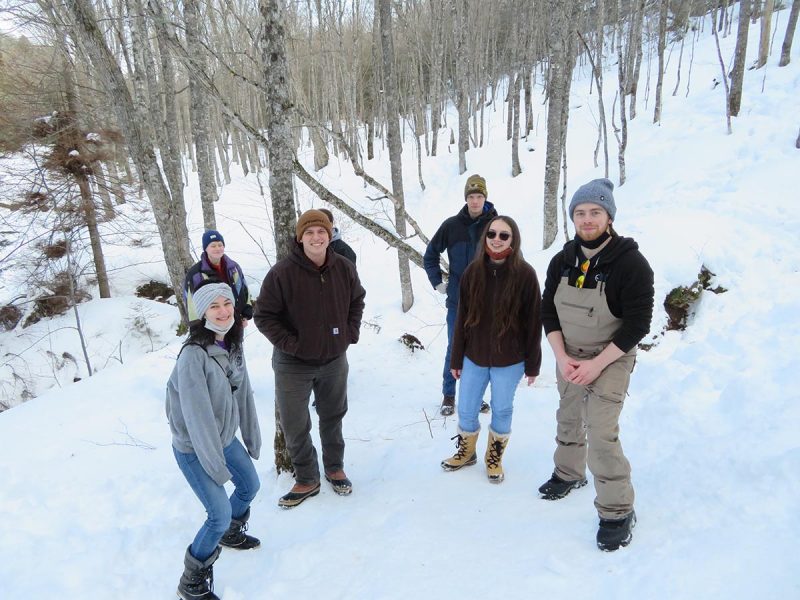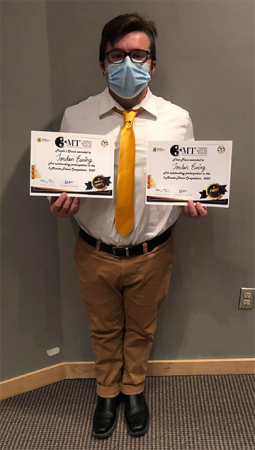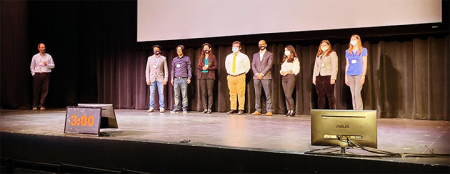The 2021 American Institute of Professional Geologists (AIPG) Student Chapter of the Year Award goes to Michigan Technological University for the second year running!
Each year, AIPG recognizes the most outstanding student chapter for its activities, achievements, and contributions to the Institute. Nationwide there are 55 student chapters at AIPG. The award letter states: “the Student Chapter at Michigan Tech stood out among the AIPG Student Chapters in the nation this past year, and are highly deserving of this distinction and honor.”
Currently, the chapter officers are Elana Barth (President, Geology), Olivia Salvaggio (Vice President, Geophysics), Emilie Pray (Treasurer, Geology), and Nolan Gamet (Secretary, Geology). The officers during the year of the award were Elana Barth (President, Geology), Breeanne Huesdens (Vice President, Geological Engineering), Emilie Pray (Treasurer, Geology), and Makala O’Donnell (Secretary, Geological Engineering).
Chad Deering, Associate Professor in the Department of Geological and Mining Engineering and Sciences, and David Adler, a Mannik & Smith Group Certified Professional Geologist (B.S. Geology ‘82), advise the Michigan Tech chapter.
Congratulations once again on a job well done. The GMES department is proud of your continued success!
Snehamoy Chatterjee and Jeremy Shannon have been appointed to two endowed faculty fellow positions in the Department of Geological and Mining Engineering and Sciences (GMES).
Witte Family Endowed Faculty Fellow in Mining Engineering

Chatterjee, associate professor in GMES, has been appointed the new Witte Family Endowed Faculty Fellow in Mining Engineering, a position created to retain and attract highly qualified faculty who are at the top of their profession, inspire students to think beyond the classroom material, and integrate their research into the classroom.
Chatterjee was instrumental in developing GMES’s new interdisciplinary program in mining engineering and now teaches several key courses for this program. He continuously updates his courses to adopt new teaching and technological approaches and incorporates research in his instruction. He is always looking out for students’ best interests by seeking ways for them to participate in research and design projects in order to enhance their learning and professional development.
Carl G. Schwenk Faculty Fellow in Applied Geophysics
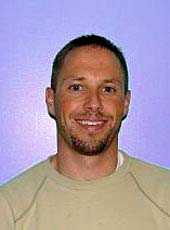
Shannon, principal lecturer and undergraduate student advisor in GMES, is the new Carl G. Schwenk Faculty Fellow in Applied Geophysics, a position established to provide students with practical knowledge and intuition that, when combined with exceptional instruction, promotes mobility for an impactful and rewarding career in the field of applied geophysics.
Shannon provides instruction for nearly all courses in the field of applied geophysics and lends his expertise to Senior Design courses and graduate students whose research involves field geophysics. He also maintains GMES’s field geophysics equipment, and has been successful in obtaining funding to purchase new equipment. (During one of Carl Schwenk’s previous visits, Jeremy showed him both our current equipment as well as past equipment that had been in storage, which truly impressed Carl.)
As an academic advisor for GMES’s undergraduate majors, Shannon creates individual plans in order to offer the best academic and professional pathway for that student.
By the Office of the Provost and Senior Vice President for Academic Affairs.
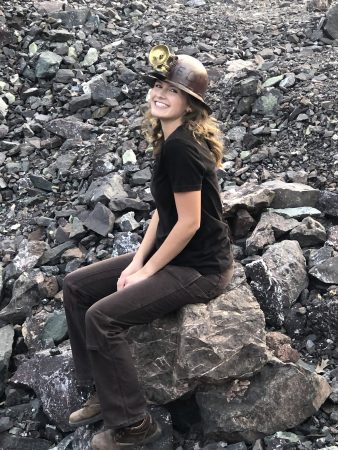
Emily Street, a fourth-year mining engineering student at the Department of Geological and Mining Engineering and Sciences, received the prestigious, highly competitive Copper Club Lord Bagri Scholarship. Her essay, ‘The Importance of Copper in the 21st Century,’ gives the reader a passionate viewpoint, written by an outstanding, hardworking student ancestrally connected to the industry.
The Copper Club, Inc, formed in 1944, is the leading organization for networking, educational grants, and events for those who support the copper industry. The Copper Club Scholarship Fund provides scholarships to students majoring in geoscience or other fields related to the production of copper or copper products. A $15,000 award goes to one student who shows exceptional merit demonstrated by excellent grades, with a necessity for financial aid. In letters of recommendation, Michigan Tech faculty can quote praising, “… she will be a role model for the next-generation mining and geosciences students”, and “…Ms. Street will have a transformative impact on the mining industry as she transitions from student to professional.” A well-deserving student to receive this award, indeed.
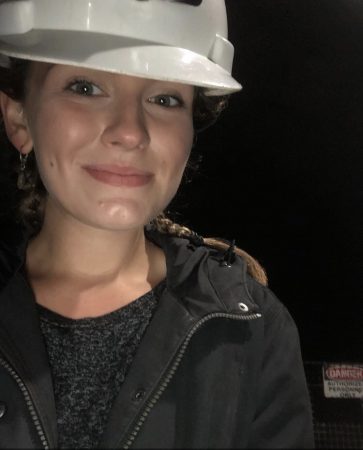
“I was honored to be nominated as MTU’s representative for the Copper Club Scholarship 2021-22, and I am humbled to represent the college as a recipient of The Lord Bagri Scholarship. I am thankful to be a part of the mining engineering program at MTU and to have the opportunity to be taught by such passionate and knowledgeable industry leaders. I am currently working as a summer mine engineering intern at LafargeHolcim in Presque Isle, Michigan; I hope to use the hands-on experience I gain at the quarry this summer to further my knowledge in my senior year in the program. Attending Michigan Tech’s newly resurrected mining engineering program, while a rigorous curriculum, has taught me more than I could have ever imagined. I am proud to be a student here, at what was originally the Michigan Mining School, and to be able to work as a miner in the industry that brought my family to the Keweenaw nearly one hundred years ago!” – Emily Street
https://www.copperclub.org/scholarships-awards/

Dr. Adam Durant (MS Geology ’06, PhD ’07) discussed how modifying flight plans lessen long-lasting contrails and reduce climate impacts–so-called green aviation. Physics professor Raymond Shaw and Professor Emeritus Bill Rose, who advised Adam in his graduate studies here, host the discussion.
It’s not rocket science. It’s harder — or at least harder to predict. Clouds are often referred to as the wildcard of climate modeling, and while some basic physics have become much clearer using tools like the cloud chamber at Michigan Technological University, atmospheric science remains a fascinating and complex space.
Shaw, distinguished professor of physics and director of Michigan Tech’s atmospheric sciences doctoral program, studies ice crystal formations in clouds. When Durant worked with him as a graduate geoscience student, the team studied how volcanic ash and frigid water interact in the atmosphere. For Durant, experimenting with specks of dust and drops of supercooled water coalesced into an ongoing interest in the interaction’s effects on airplanes — and the industry’s climate bill. Drawing on his interdisciplinary background, Durant started the company SATAVIA in 2013.
In their Q&A, Shaw (RS) and Durant (AD) explain how rerouting airplanes to minimize contrails can have the biggest impact with the smallest changes.
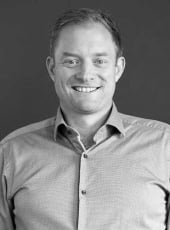
Adam Durant, CEO SATAVIA
Research Interests:
– Green aviation
– Ice crystal morphology and cloud formation
– Volcanic ash plumes
– Sustainable business
Q: Why focus on contrails to curb climate change impacts?
AD: It’s not just direct engine emissions that matter in terms of aviation’s climate impacts. Non-carbon dioxide sources — like the climate forcing from contrails — make up almost two-thirds of the industry’s impact, which is a surprisingly big number. In fact, it equates to 2% of all human-caused climate change.
RS: Contrails are pretty and localized, so it’s understandable that few people would guess they’re of consequence. And it’s relatively rare flights that make these long-lasting contrails, which are heavily weighted in terms of their climate impact.
AD: Yes, of about 500 flights, only one or two make these kinds of contrails.
Q: How does SATAVIA’s software help predict contrail formation?
AD: We are a data analytics company, building software that uses cutting-edge atmosphere and climate science. We use a commercial cloud structure to create a digital twin of the Earth’s atmosphere from surface to space, quantifying many key meteorological parameters like temperature, humidity, cloud cover and other factors that affect flight operations. We aggregate that information and apply it to different use cases, including contrail formation and other applications such as contaminant exposure and corrosion factors. Predicting contrail formation and persistence in the atmosphere is complex, so it becomes a big data problem – unless you’ve got a high-performance atmospheric digital twin, you won’t be able to crunch through the data properly. Right now, we’re working with a major Middle East airline through a collaboration with Aviation X Lab, a Dubai-based aviation incubator. They want to be proactive about assessing their impact, and they’re helping us validate our models. The next challenge is software integration, so we can help airlines optimize flight paths for contrail prevention while minimizing fuel burn.
Q: How can industry, universities and government groups work together?
RS: It’s important to acknowledge that while Michigan Tech doesn’t have direct collaborations with SATAVIA, it was a former student who started the company and a new graduate, Subin Thomas, starts there soon as a key player on their science team. Academia can play a role by training people in the fundamental science so they can carry on innovation within the private sector. We also work with agencies, like our partners at the National Center for Atmospheric Science (NCAR) and U.S. Department of Energy (DOE). For example, a current graduate student, Elise Rosky, is at this moment at NCAR flying a holographic instrument through clouds to investigate how ice forms and grows. Who knows where that fundamental research will lead, and even how it might tie into the science of contrails?
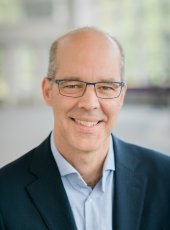
Raymond Shaw
Research Interests:
– Atmospheric Physics
– Cloud Physics
– Nucleation
– Turbulence
– Digital Holography
AD: We all want to solve real world problems. There’s a lot more to solving problems than throwing science at it. If it doesn’t cost money or make money, it’s hard to get business to care. As the cost of carbon rises, there is going to be more and more incentive for airlines to fly smarter and greener. With our model, we not only assess a flight plan and help make changes that actually lower aviation’s climate impact, but we also estimate what a company can save in associated carbon credits and carbon offsets.
Q: How did your Michigan Tech research help make these kinds of collaborations possible?
AD: This brings me back to doing my PhD on volcanic ash with Bill Rose, who blended a lot of disciplines. I felt like an atmospheric scientist but my degree was geoscience. I moved on to a climate research group next — mostly climate modelers and remote sensing experts — and that experience also brought me closer to policy.
RS: Sometimes, Adam, we jokingly call students like you a gluon [bad physics joke] — “Well, Bill does this and Raymond does that, so we need a go-between.” To Bill’s credit, he was always roving and looking for people who could help him solve the problems he was working on. So, Adam asked in his research: What happens when we put ash in a supercooled droplet? It was a logical next step to ask what happens when an airplane flies into an ash plume.
Q: What inspires you in your work?
AD: I want to take tangible action on climate change — that’s what my mission has become. We’ve been thinking about our vision as a company and it always comes back to solving climate change.
RS: We say all the time that we do basic science to help society. Examples like Adam’s company make that true. In some ways, it’s easier to stay in academia, but moving into the private sector means there is so much more potential for influence. Much of research is curiosity-driven and with a genuine interest in solving fundamental problems, with the hope that eventually the solutions will make a difference. But no one would fund us to solve puzzles every day; we hope that when we train students that our fundamental work will be connected to the private sector and help make the world a better place.
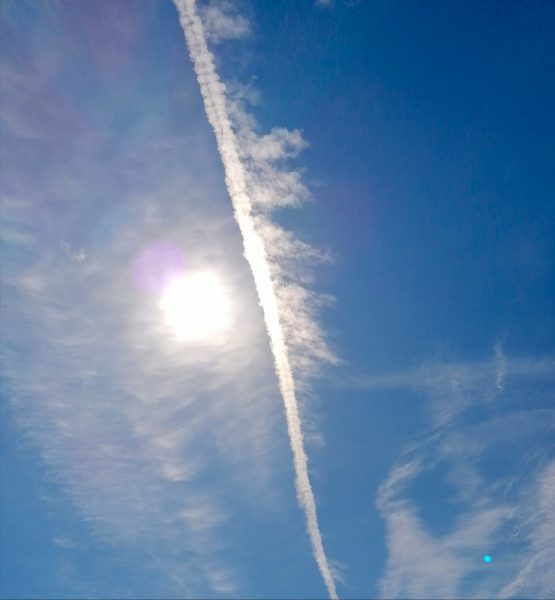
Q: What are challenges that remain ahead?
AD: Raymond, here is what we are always asked: Do we know enough about the science of contrail formation and whether we can predict it?
RS: Well, the basic physics is there. The part that is complicated, which falls under current research, is how persistent will a contrail be — will it be ice or water, and what’s the crystal shape? The good news is that the basics are clear.
AD: I agree that the fundamental science is sound, and that the challenge facing us now is scaling and creating contrail forecasts at flight altitudes so that aviation operators can avoid making them. And policy and regulation — that is what will influence how big organizations deal with this problem.
RS: That’s the surprising part. Thinking from the company spreadsheet point of view, in the right economy, SATAVIA’s approach can actually save money.
AD: Yes, many companies already pay to offset their carbon emissions. Changing flight plans would make a bigger difference and save them more money. What we need to work on most from a technical perspective is software integration, and that’s going to take time and close partnerships with more airlines.
Q: The pandemic changed travel. How has this impacted your work?
AD: Before COVID, much of our work focused on how atmospheric and climatic factors can damage aircraft engines and airframes, and responding to that with smarter condition monitoring and predictive maintenance.
But as the pandemic began and continued, we pivoted to focus more on aviation’s impact on climate. We just happened to be at the right place at the right time with our ice crystals research. People care about green aviation now, to the extent that it will influence their choice of airline, though some consumers will always be driven by the cheapest prices. In the near term, it’s likely to be business travelers who care most about the green credentials of a flight.
RS: Even before the pandemic, I was starting to notice an uptick in the number of colleagues who would say, “I’m not going to go to that meeting because I’m trying really hard to minimize the aviation part of my carbon footprint.” Or saying, “I can’t go on that airline, I’m going to choose this other airline because they’re doing more to solve this problem.” And I do think the pandemic has made more of us aware of what can and can’t be done. The nice thing is that we can have a global aviation industry and mitigate the impact to some extent. As you think about returning to air travel, why not expect more from the airline you’re flying with? Because there are actions they can take. Contrails are something most people would never think about, but SATAVIA’s work shows that it’s possible to do something about their climate impacts.
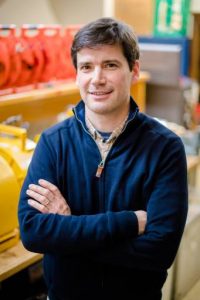
Congratulations to the Geological and Mining Engineering and Sciences (GMES) faculty members promoted in the 2020-21 academic year!
Dr. Gregory Waite, Associate Professor, was promoted to the rank of full Professor. Dr. Waite is a nationally and internationally recognized expert in seismology with particular emphasis on studies of fluid processes and modeling of volcano seismic and infrasound signals. Dr. Waite and his students conduct studies of active volcanic processes using field data, laboratory analog experiments, and computer modeling. This research is critical to monitoring and forecasting volcanic eruptions. Dr. Waite actively collaborates with scientists from Central and South America, Europe, and Japan. He has published many peer-reviewed articles in top-tier international journals. Dr. Waite is the recipient of a prestigious National Science Foundation CAREER award and has secured additional grants from NSF and the U.S. Geological Survey.
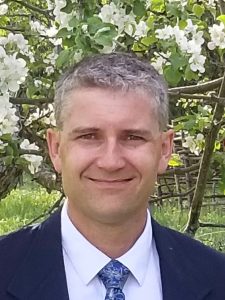
Dr. Nathan Manser, Lecturer, was promoted to the rank of Senior Lecturer. Dr. Manser provides vital contributions to GMES teaching and advising activities, including his instrumental role in the success of our newly reinstated program in Mining Engineering. He has substantial teaching and advising experience as well as extensive experience in the mining industry. He has published several peer-reviewed papers in environmental and mining engineering. Dr. Manser is a dedicated and effective instructor and adviser as well as an impactful and trusted mentor. Dr. Manser serves as the academic advisor for Mining Engineering and the Chair of the Mining Engineering Curriculum Committee. He also serves as faculty advisor for several student organizations, including the GMES Chapter of the Society for Mining, Metallurgy and Exploration (SME) and the SME/NSSGA Student Design Team.
Both promotions were approved at Michigan Tech’s Board of Trustees meeting on April 30 and will be effective on August 16, 2021.
New alumni can get connected to mentors and more on the Michigan Tech Alumni and Friends network: https://www.mtu.edu/alumni
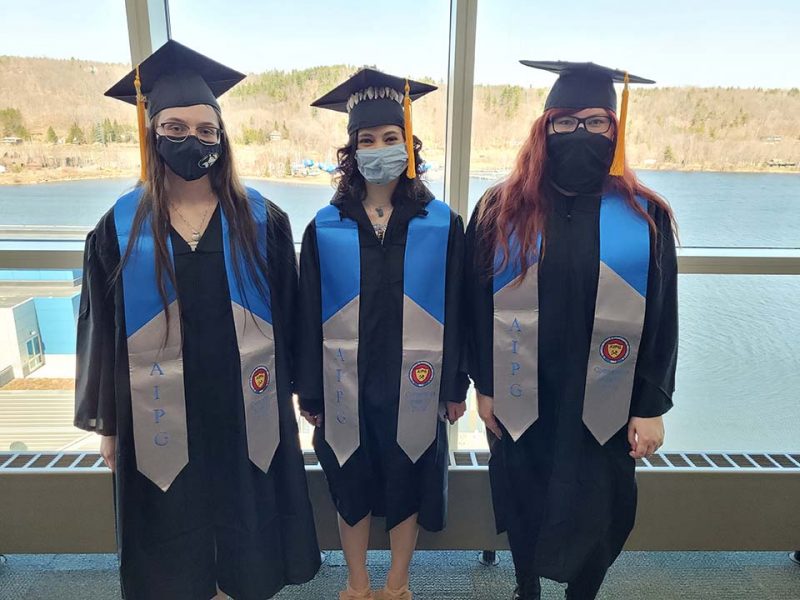
This year, graduating Huskies took part in a festive outdoor celebration. The graduation walk for the Classes of 2021 and 2020 through campus on April 30 was such a tremendously great time, we hope it can become a new tradition. It was a blue-sky, picture-perfect day we’ll never forget.
GMES 2020-21 Degrees Granted
Summer 2021
BS EGE Caleb Kaminski
BS EGE Donelle Auten
BS EGE Makala O’Donnell
BS EGE Anderla, Maddy M.
MS EGL Pauline Verdurme
Spring 2021
BS EGE Heusdens, Breeanne M.
BS EGL Barth, Elana G.
BS EMG Neely, Benjamin A.
MS EGE Iuliia Tcibulnikova
MS EGL Sophie Mueller
PHD EGL Olivia Barbee
Fall 2020
BS EGE Abigail P. Friedl
BS EGE Dustin R. Helmer
MS EGE Ian O. Nichols
MS EGE Katelyn Elizabeth Kring
MS EGE Kelsey Anne Kirkland
MS EGL Celine Mei-An Carus
MS EGL Claudia Buondonno
MS EGL David Jokob Kelly
MS EGL Davide Saviano
MS EGL Evan Robert Lanese
MS EGL Heather Thole
MS EGL Robert Matthew Booth
MS EGL Roberto Cuahutemoc Armijo
MS EGL Roberto Piemontese
MS EGP Adam Bautzmann
MS EGP Erdi Apatay
MS EGP Katie E. Bristol
MS EGP Martine Hope Loevaas
MS EGP Mohamed Mahmoud Shawky Abuzaied Mohamed
MS EMG Adel Asadi
PHD EGE Chandan Kumar
PHD EGP Haitao Cao
PHD EMG Amol Paithankar
Summer 2020
BS EAG Eric Oliveira
BS EMG Garrett J. Singer
MS EGE Joyata Yatinkumar Raval
Spring 2020
BS EAG Dayol Carvalho
BS EAG Fernando J. Chambole
BS EAG Janayna C. Manuel
BS EAG Max L. Douglas
BS EGE Allyson M. Hartz
BS EGE Arie P. Ruiter
BS EGE Bobby G. Hirvi
BS EGE Ginny E. Hemmila
BS EGE Ian M. Gannon
BS EGE Steve E. Wright
BS EGE Tucker T. Scoville
BS EGL Evelyn T. Jobe
BS EGL James D. Yiu
BS EMG Drake D. Wilson
BS EMG Shawn M. Vandoorn
MS EGL Sentle Augustinus Hlajoane
“There is no doubt that through your hard work, tenacity, and perseverance, you have earned all of the rights and privileges that come with a degree from Michigan Tech.”
The 2020-21 Academic Year brought the following student achievements to GMES:
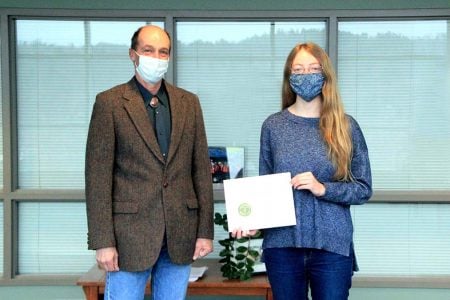 Grace Ojala receives American Institute of Professional Geologists (AIPG) National Scholarship – Congratulations to Grace Ojala (Applied Geophysics), who was awarded a prestigious American Institute of Professional Geologists National Scholarship! Grace pursues a double major in Applied Geophysics and Anthropology, working towards a career that utilizes geophysics to advance archaeology. In addition to her excellent academic standing, Grace is actively involved in several research projects, including a satellite data processing project (supervised by AssociateProfessor Dr. Snehamoy Chatterjee) supported by the Michigan Space Grant Consortium. The award was presented in person by Bill Mitchell, the president of the Michigan Section of AIPG.
Grace Ojala receives American Institute of Professional Geologists (AIPG) National Scholarship – Congratulations to Grace Ojala (Applied Geophysics), who was awarded a prestigious American Institute of Professional Geologists National Scholarship! Grace pursues a double major in Applied Geophysics and Anthropology, working towards a career that utilizes geophysics to advance archaeology. In addition to her excellent academic standing, Grace is actively involved in several research projects, including a satellite data processing project (supervised by AssociateProfessor Dr. Snehamoy Chatterjee) supported by the Michigan Space Grant Consortium. The award was presented in person by Bill Mitchell, the president of the Michigan Section of AIPG.
Grace Ojala also received a prestigious scholarship from the Society of Exploration Geophysicists (SEG). The competitive SEG scholarships are based on merit and have been awarded to students all over the world to encourage the study of geophysics and related geosciences.
Emilie Pray – 2021 Department Scholar Award – Congratulations to Emilie Pray (BS Geology), who received a 2021 GMES Department Scholar Award to recognize her scholarly achievements! This award, presented to a student entering their senior year, recognizes one who best represents student scholarship in the department by participating in research or scholarly activities, demonstrating a high level of intellectual curiosity and creativity, and showing excellent communication skills. Emilie participates in research led by Associate Professor Dr. Chad Deering on deciphering a complex geological history of the central-eastern UP using petrological and geochemical data.
Congratulations to the recipients of Michigan Space Grant Consortium grants:
Diana Bullen (MS), Using a Biologically Enhanced Silica Recovery System to Retrieve Valuable Non-Renewable Resources from Waste Material (advisor: Dr. Nathan Manser)
Ian Gannon (MS), Critical Mineral Potential in the Vulcan Quadrangle and Adjoining Areas, Dickinson County, Upper Peninsula of Michigan (advisor: Dr. James DeGraff)
Brock Howell (MS), Effective Optimization of Groundwater Extraction Through the Development of Computational Tools (advisor: Dr. John Gierke)
Ryan Klida (MS), Satellite Based Synthetic Aperture Radar (SAR) Techniques for Earth Dam Monitoring and Failure Prediction (advisor: Dr. Thomas Oommen)
Katie Nelson (Ph.D.), Measuring CO2 fertilization of tropical forests from volcanic soil gas emissions using remote sensing: Volcán Rincón de la Vieja, Costa Rica (advisor: Dr. Chad Deering)
Kassidy O’Connor (MS), Using Satellite Aperture Radar to Improve Wildfire-Causing Debris Flow Mapping on the West Coast (advisor: Dr. Thomas Oommen)
Congratulations to the recipients of these additional awards and recognitions:
Beth Bartel (Ph.D.) – Smithsonian Institution Fellowship–Robert D. Hevey, Jr. Ten-Week Graduate Student Fellow in Mineral Sciences at the National Museum of Natural History (NMNH). Project title, “Reconstructing Disaster: An Analysis of Digital Communications During Volcanic Crises.”
Natalea Cohen (MS) – National Association of Geoscience Teachers (NAGT) Internship with the USGS Volcano Science Center. (Summer 2021)
Cristhian Salas (MS) – Outstanding Graduate Student Scholar (Spring 2021)
Nelmary Rodriguez (MS) – Outstanding Graduate Teaching Award (Spring 2020); Outstanding Graduate Student Scholar (Fall 2020)
Jordan Ewing (Ph.D.) – Won first place at the 2020 3MT Competition with his presentation, “Terrain Traversing: X Marks the Spot,” in addition to winning the People’s Choice Award. (Fall 2020) Jordan also received an outstanding achievement certificate from the U.S. Army DEVCOM Analytics division. (Spring 2021)
Elana Barth (BS Geology) – Ishpeming Rock and Mineral Club Annual Earth Science Award (Spring 2021)
Chandan Kumar (Ph.D.) – Outstanding Scholarship Award (Fall 2020)
Beth Bartel (Ph.D.) – Outstanding Graduate Teaching Award (Fall 2020)
Amol Paithankar (Ph.D.) – Outstanding Scholar Award (Spring 2020)
Katie Nelson (MS) – Outstanding Teaching Award (Spring 2020)
Congratulations from all of the faculty and staff in GMES!
The College of Engineering has selected Jeremy Shannon, principal lecturer in the Department of Geological and Mining Engineering and Sciences (GMES), for this week’s Deans’ Teaching Showcase. Dean Janet Callahan selected him for teaching excellence in a field course.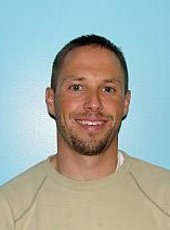
Shannon joined GMES as a lecturer in 2007. He teaches a variety of courses throughout the year including Understanding the Earth (GE2000), a large course that is taken by many non-major students. Department Chair Aleksey Smirnov (GMES) says “Dr. Shannon provides a vital contribution to GMES undergraduate instruction and advising. He is an outstanding instructor and an impactful and trusted mentor.”
One of Shannon’s favorite courses is Field Geophysics (GE3900), a summer, a five-credit course required for Geological Engineering, Geology, and Applied Geophysics majors. Most geoscience programs only require a field geology course, so this class provides an extremely unique, hands-on experience for GMES students. The five-week-long class is set up like a consulting job with weekly projects. Each project uses a different geophysical technique, or a combination thereof, with specified goals. As one student put it, “Jeremy had an innate ability to connect with us all, especially on field trips. He utilized more field visits than any other professor I had at Tech. This gave me real-life scenarios and examples to help cement concepts I had learned in the classroom.”
A typical week involves fieldwork, the reduction, interpretation and modeling of data, and a final written report or oral presentation. Shannon worked for a few years in environmental consulting and likes that he can share with students his own experiences that mimic the format of this class, especially the report writing. This class offers one of the best opportunities in the GMES curriculum for practice in scientific writing, an invaluable skill that will translate directly for students that either choose employment or decide on graduate school. A recent alumnus observed that Shannon made sure the students also “focused on the hard work that occurred back in the classroom completing the reports to improve students’ report writing skills. Jeremy had very high standards for the reports. His resolve in consistent writing and proper formatting for all reports significantly influenced my use of proper documentation, even today.”
Shannon is an MTU alumnus and took the Field Geophysics class as an undergraduate in the summer of 1992. He was honored to take over the class in 2007 from his former professor and mentor Dr. Jimmy Diehl, who taught it for 25 years. He has continued and built upon this legacy to deliver a unique field experience to GMES students. In particular, Shannon has proactively worked to upgrade the geophysical equipment which is typically expensive. Over the last several years, with the help of departmental, alumni, and C2E2 funding, new seismic refraction and ground-penetrating radar systems were purchased. Other equipment includes magnetometers, electrical resistivity meters, electromagnetic instruments, and one precious gravity meter. And he makes using the equipment fun. Another student said, “Jeremy helps students to see the joy in fieldwork. He makes it exciting to see seismic waves be recorded by a geophone, or he encourages us to be patient in aligning the gravimeter.”
The class projects typically target objects or structures within tens of meters below the surface. The projects include determining depth to bedrock and water table, mapping contacts between different rock types, or locating buried metallic and non-metallic objects on the site of a Calumet & Hecla stamp mill in Lake Linden. About five years ago, Shannon collaborated with the Michigan DNR and had the class perform geophysical surveys to delineate a buried bedrock valley near McLain State Park. There is no definite surface expression of the valley as it is filled with glacial till, but a gravity survey showed that the ~3 km wide and 200 meters deep valley trends to the north through a portion of the park. The absence of bedrock near the surface where the valley is located is precisely the location where significant beach erosion is taking place. These results became part of the decision-making process, which resulted in the recent restructuring of the park layout.
Dean Callahan summarizes: “Shannon’s dedication to continually improve the field course provides a unique learning environment for our students in which they develop skills that they will use throughout their careers. He is very deserving of this recognition.”
Shannon will be recognized at an end-of-term luncheon with other showcase members, and is also a candidate for the CTL Instructional Award Series (to be determined this summer), recognizing introductory or large-class teaching, innovative or outside the classroom teaching methods, or work in curriculum and assessment.
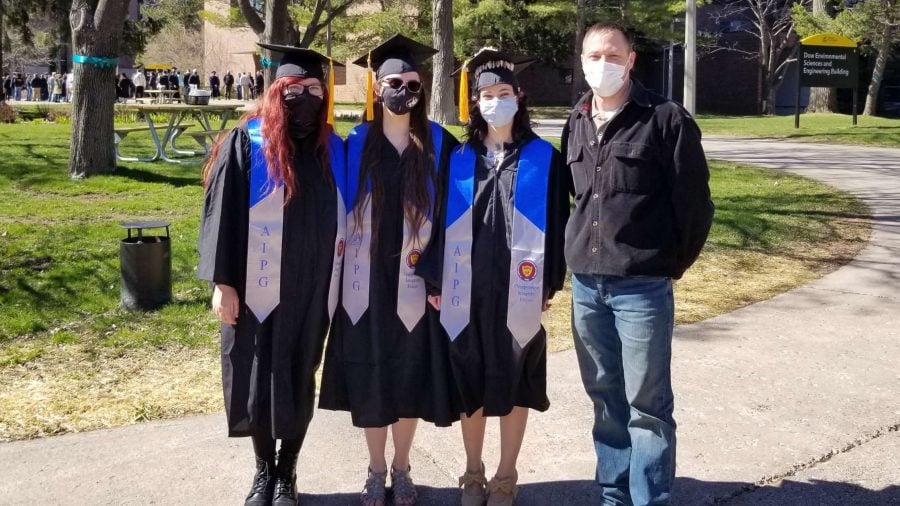
Written by Aleksey Smirnov, Chair of Geological and Mining Engineering and Sciences
Jordan Ewing, Ph.D. student in GMES, won first place with his presentation “Terrain Traversing: X Marks the Spot”. Ewing also won the People’s Choice Award for his presentation. He will go on to represent Michigan Tech at the regional competition.
The runner up is Ninad Mohale, Ph.D. student in the Materials Science & Engineering department, with his presentation “Development of a Physically-Based Creep Model Incorporating ETA Phase Evolution for Nickel-Base Superalloys”.
The other finalists were: Masoud Ahmadi and Sadaf Batool, Ph.D. students in Mechanical Engineering & Engineering Mechanics; Parya Siahcheshm, Ph.D. student in Chemistry; Rachel Hetherington, Ph.D. student in GMES; Shardul Tiwari, Ph.D. student in Social Sciences, and Emily Lindback, MS student from the College of Forest Resources & Environmental Science.
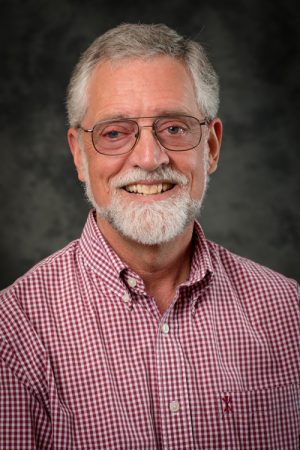 Professor Emeritus Ted Bornhorst (GMES), has been selected by the Michigan Museum Association (MMA) for one of its 2020 MMA Member Awards in the “Colleague Champions” category.
Professor Emeritus Ted Bornhorst (GMES), has been selected by the Michigan Museum Association (MMA) for one of its 2020 MMA Member Awards in the “Colleague Champions” category.
Bornhorst will be recognized at a virtual celebration hosted by MMA on Nov. 19, in recognition of his work that allowed the A. E. Seaman Mineral Museum to safely reopen to the public on July 1, and to plan a smooth transition of leadership of the museum upon his retirement as executive director and interim curator.

